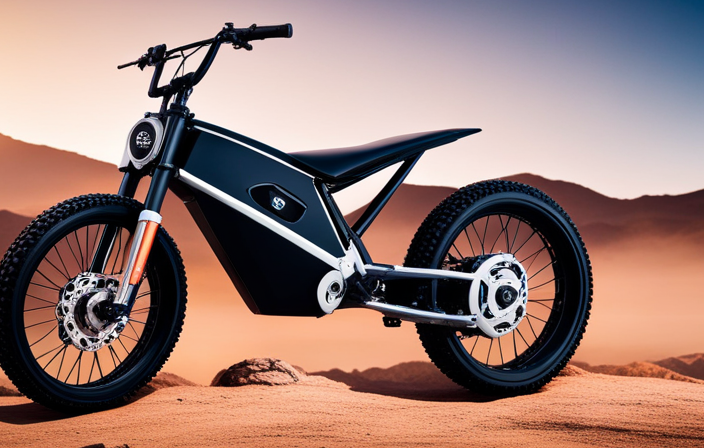I love the feeling of cruising on my electric bike, but keeping the battery charged can be a challenge. It’s like having a trusty companion that needs a little extra care.
In this article, I’ll share my knowledge on how to charge an electric bike battery with ease. We’ll dive into understanding different battery types, finding the perfect charging spot, and gathering the necessary equipment.
By following these precise steps, you’ll be able to keep your battery fully charged and ready for your next adventure.
Key Takeaways
- Different battery chemistries require different charging methods and precautions.
- Look for a well-ventilated area with access to a power outlet for charging.
- Understand the charging voltage requirements of your battery and use a compatible charging cable.
- Regularly monitor the charging process, follow proper battery maintenance, and store the battery correctly.
Understand Your Battery Type
To charge your electric bike battery, you need to understand its type and specifications. Different battery chemistries require different charging methods and precautions. The most common types of batteries used in electric bikes are lithium-ion and lead-acid batteries.
Lithium-ion batteries are lighter and provide longer range, while lead-acid batteries are cheaper but heavier.
When it comes to charging your battery, it’s important to follow the manufacturer’s instructions and recommendations. Improper charging can lead to reduced battery life and potential safety hazards. For lithium-ion batteries, it’s crucial to use a charger specifically designed for that chemistry. Avoid using chargers meant for lead-acid batteries, as they can cause damage.
Proper battery storage is also essential for maintaining its performance and longevity. If you’re not using your electric bike for an extended period, make sure to store the battery in a cool and dry place. Avoid exposing it to extreme temperatures or direct sunlight, as it can degrade the battery’s capacity.
Understanding your battery type and its specifications will help you charge it correctly and maximize its lifespan. Now that you know how to handle your battery, let’s move on to finding a suitable charging location.
Find a Suitable Charging Location
When it comes to finding a suitable charging location for your electric bike, there are a few key points to consider.
Firstly, it’s important to look for a well-ventilated area that allows for proper airflow during the charging process.
Additionally, make sure the location has easy access to a power outlet, as this will ensure a seamless charging experience.
Lastly, for added convenience, you may want to consider using a dedicated charging station or wall mount specifically designed for electric bikes, as these can provide a secure and organized charging solution.
Look for a well-ventilated area with access to a power outlet
You should find a spot that’s well-ventilated and has a power outlet nearby to charge your electric bike battery. Here are some important points to consider when choosing a suitable charging location:
-
Avoid charging your battery in extreme temperatures: High temperatures can degrade the battery’s performance and lifespan, while low temperatures can reduce its charging capacity.
-
Choose a location away from flammable materials: To ensure safety, it’s crucial to charge your battery in an area free from combustible materials such as gasoline, solvents, or any other potential fire hazards.
-
Keep your battery away from moisture: Moisture can damage the battery and its electrical components. It’s essential to charge your electric bike battery in a dry area to prevent water damage.
-
Ensure proper ventilation: Charging your battery generates heat, so it’s vital to charge it in a well-ventilated area to prevent overheating and maintain optimal battery performance.
Considering these factors will help ensure battery maintenance and charging safety. For added convenience, consider using a dedicated charging station or wall mount, which allows for easy access and keeps your charging setup organized.
Consider using a dedicated charging station or wall mount for convenience
For added convenience, using a dedicated charging station or wall mount keeps everything organized and easily accessible.
Dedicated charging stations are specifically designed to charge electric bike batteries efficiently and safely. They often come with multiple charging ports, allowing you to charge multiple batteries simultaneously. These stations also provide a stable and secure platform for your bike while it charges.
Alternatively, wall mounts are a great option if you have limited space. They allow you to mount your charger on the wall, keeping it off the floor and out of the way. This not only saves space but also prevents any potential tripping hazards.
By utilizing dedicated charging stations or wall mounts, you can ensure that your charging process is streamlined and hassle-free.
Now, let’s move on to the next step: gathering the necessary charging equipment.
Gather the Necessary Charging Equipment
First off, make sure you’ve got the necessary charging equipment for your electric bike battery. Understanding the charging voltage and choosing the right charging cable are crucial steps in ensuring a safe and efficient charging process. Here are a few things to consider:
-
Charging Voltage: Before purchasing a charging cable, it’s important to understand the voltage requirements of your electric bike battery. Different batteries may have different voltage specifications, so make sure to check your bike’s manual or consult with the manufacturer to determine the appropriate charging voltage.
-
Choosing the Right Charging Cable: Once you know the charging voltage, you can select the right charging cable. Look for a cable that is compatible with your bike’s charging port and has the appropriate connectors. It’s also important to choose a cable that is of high quality and can withstand the electrical load during charging.
-
Safety Features: Consider investing in a charging cable with built-in safety features such as overcharge protection and short circuit prevention. These features can help prevent any potential damage to your battery or electrical system.
-
Length and Durability: Lastly, consider the length and durability of the charging cable. A longer cable can provide more flexibility in terms of where you can charge your bike. Additionally, opt for a cable that is durable and can withstand frequent use and outdoor conditions.
With the necessary charging equipment in hand, it’s time to prepare your bike for charging.
Prepare Your Bike for Charging
Once you’ve gathered the necessary charging equipment, it’s time to prepare your electric bike for charging. Proper battery maintenance is crucial to ensure optimal performance and longevity.
Before connecting the charger, there are a few key steps to follow. First, ensure that your bike is turned off and the key is removed from the ignition. This will prevent any accidental power surges during the charging process.
Next, locate the charging port on your bike. It is typically located near the battery and will have a protective cover. To access the charging port, gently remove the cover and check for any debris or dirt. It’s important to keep the charging port clean to ensure a secure connection and efficient charging. If there is any buildup, use a soft cloth or brush to carefully clean it.
Now that your bike is ready for charging, let’s take a moment to talk about portable chargers. These compact chargers are convenient for on-the-go charging and can be easily stored in your backpack or bike bag. They are especially useful for long rides or when you don’t have access to a traditional charging station.
As you can see, preparing your bike for charging is a simple process that ensures optimal performance and battery life. Now, let’s move on to the next step and connect the charger to the battery.
Connect the Charger to the Battery
Now that you’ve located the charging port, it’s time to connect the charger to the battery. Proper battery maintenance and charging techniques are crucial to ensure the longevity and performance of your electric bike’s battery.
Start by taking the charger and locating the matching connector on your bike’s battery. The connector will usually have a specific shape or size that fits seamlessly with the charger. Align the connector and gently insert it into the charging port until it clicks into place. Make sure the connection is secure to avoid any interruptions during the charging process.
Next, plug the charger into a power outlet. Ensure that the power outlet is in good working condition and has the appropriate voltage for your battery. It is important to use the charger provided by the manufacturer or a compatible charger to avoid any compatibility issues or damage to the battery.
Once the charger is connected to both the battery and the power supply, you can start the charging process. The charger may have an indicator light that shows the charging status. Typically, a red light indicates that the battery is still charging, while a green light signifies a fully charged battery. It is essential to monitor the charging process to prevent overcharging, which can negatively impact the battery’s lifespan.
Monitor the Charging Process
To ensure optimal battery performance, keep an eye on the charging process and regularly check the indicator light.
Battery maintenance is crucial for the longevity of your electric bike’s battery. When charging your battery, it is important to monitor the charging process to troubleshoot any potential issues.
Start by plugging the charger into a power outlet and connecting it to your bike’s battery. Look for the indicator light on the charger, which will let you know if the battery is charging properly. A solid green light indicates that the battery is fully charged, while a flashing green light suggests that the battery is still charging. If you notice a red light or no light at all, there may be a problem with the charger or the battery itself.
In such cases, it is recommended to consult the user manual or contact the manufacturer for further assistance. By regularly monitoring the charging process and addressing any troubleshooting issues promptly, you can ensure the longevity and reliability of your electric bike’s battery.
To maintain a regular charging schedule, it is important to establish a routine that suits your needs and riding habits.
Maintain a Regular Charging Schedule
As an experienced electric bike owner, I’ve learned the importance of establishing a routine for charging my battery. By consistently charging my battery at specific times, I can ensure that it’s always ready for my next ride.
Additionally, I’ve found that avoiding letting the battery completely drain before charging is crucial. This helps maintain its overall lifespan and performance.
Establish a routine for charging your electric bike battery
Make sure you establish a regular routine for charging your electric bike battery. Proper battery maintenance is crucial for maximizing its lifespan.
To ensure optimal performance, it’s important to follow a few key guidelines.
First and foremost, always charge your battery after each ride, even if it’s not fully depleted. This helps maintain a consistent charge level and prevents the battery from completely draining.
Additionally, avoid leaving your battery plugged in for extended periods when it’s already fully charged, as this can cause unnecessary strain on the cells.
It’s also advisable to store your battery in a cool and dry place when not in use, as extreme temperatures can negatively impact its performance.
Avoid letting the battery completely drain before charging
It’s crucial to avoid completely draining the battery before charging. Battery maintenance is a vital aspect of ensuring the longevity and performance of your electric bike. When the battery is allowed to drain completely, it can lead to irreversible damage and significantly reduce its lifespan. To emphasize the importance of avoiding complete battery drainage, let’s take a look at the following table:
| Battery Charge Level | Battery Lifespan |
|---|---|
| 0-20% | Decreased |
| 20-80% | Optimal |
| 80-100% | Decreased |
As you can see, keeping the battery charge level within the 20-80% range is ideal for maximizing its lifespan. When it comes to battery storage, it’s also important to maintain a charge level between 20-80% to prevent degradation. By following these guidelines, you can ensure the longevity and performance of your electric bike battery. Now, let’s move on to the next section about removing the battery once fully charged.
Remove the Battery Once Fully Charged
When you’re done charging, you can go ahead and remove the battery from your electric bike. Removing the battery is an important step in ensuring its longevity and proper maintenance. Here’s how to remove the battery and store it properly:
- Locate the battery compartment on your electric bike.
- Open the compartment and carefully disconnect the battery cables.
- Gently remove the battery from its housing, being mindful of its weight and size.
- Place the battery in a clean and dry storage container, away from extreme temperatures and moisture.
- Make sure the battery is stored in an upright position to prevent any leakage or damage.
By removing the battery after it has been fully charged, you can prevent any unnecessary drain on its power and prolong its overall lifespan. Proper battery storage is crucial to maintain its performance and ensure it is ready for use whenever you need it.
Now that you have removed the battery, let’s move on to the next step: storing the battery properly to keep it in optimal condition.
Store the Battery Properly
Now that we know how to remove the battery once it’s fully charged, let’s talk about the importance of properly storing the battery. Battery maintenance and storage are crucial to prolonging the lifespan of your electric bike battery and ensuring its optimal performance.
When it comes to battery storage, there are a few key considerations to keep in mind. Firstly, it’s important to store the battery in a cool and dry place, preferably at room temperature. Extreme temperatures can negatively impact the battery’s performance and longevity. Additionally, avoid storing the battery in direct sunlight or near heat sources.
To further protect the battery, it’s recommended to store it in a sturdy and secure container. This will help prevent any accidental damage or exposure to moisture. Furthermore, make sure to keep the battery away from flammable materials to reduce the risk of fire hazards.
To help you visualize the importance of battery storage, here’s a table outlining some key do’s and don’ts:
| DO’s | DON’Ts |
|---|---|
| Store battery at room temperature | Store battery in extreme temperatures |
| Keep battery in a dry place | Store battery in direct sunlight or near heat sources |
| Store battery in a secure container | Store battery near flammable materials |
Take Safety Precautions
To ensure safe handling, always wear protective gloves and goggles when working with the battery. Battery maintenance is crucial for the longevity and performance of your electric bike. One key aspect of battery maintenance is charging efficiency.
To maximize the efficiency of your battery charging, it is important to follow a few guidelines.
Firstly, make sure you are using the appropriate charger for your electric bike battery. Using the wrong charger can lead to overcharging or undercharging, which can significantly reduce the battery’s lifespan. Additionally, always plug the charger directly into a wall outlet and avoid using extension cords or power strips, as they can cause voltage drops and affect the charging process.
Another important factor to consider is the temperature during charging. Avoid charging the battery in extreme temperatures, as this can affect its charging efficiency and overall performance. It is best to charge the battery in a cool, dry environment.
Lastly, monitor the charging process and avoid leaving the battery on the charger for an extended period. Once the battery is fully charged, disconnect it from the charger to prevent overcharging.
By following these guidelines for battery maintenance and charging efficiency, you can ensure the optimal performance and longevity of your electric bike battery.
Now, let’s move on to troubleshoot common charging issues and find solutions to get your electric bike up and running again.
Troubleshoot Common Charging Issues
If you’re experiencing any issues while charging, a common troubleshooting step is to check the power source and ensure it is functioning properly. One of the most common charging problems is a faulty power source. To help you troubleshoot and fix common charging issues, I have compiled a table below with some techniques and solutions.
| Charging Problem | Troubleshooting Technique | Solution |
|---|---|---|
| Battery not charging | Check the power source and cable connections | Ensure the power source is functioning and the cables are securely connected |
| Slow charging | Check the charger and cable | Replace the charger or cable if damaged |
| Overheating during charging | Ensure proper ventilation and avoid charging in extreme temperatures | Charge the battery in a well-ventilated area and avoid exposing it to extreme temperatures |
Extend Battery Life
To extend the life of your electric bike battery, it’s important to avoid frequent deep discharges. Deep discharges can put unnecessary stress on the battery and reduce its overall lifespan.
Additionally, considering the use of a battery maintenance device or system can help optimize the performance and longevity of the battery by properly managing its charging and discharging cycles.
Avoid frequent deep discharges of the battery
Make sure you don’t frequently let your electric bike battery get fully discharged. This is an important aspect of battery maintenance that can help maximize its lifespan. When you allow your battery to reach a critically low level, it puts stress on the cells and can lead to irreversible damage. To illustrate the impact of deep discharges, consider the following table:
| Battery Discharge Level | Battery Lifespan |
|---|---|
| Frequent deep discharges | Shortened |
| Occasional deep discharges | Moderately shortened |
| Rare deep discharges | Maximized |
As you can see, avoiding frequent deep discharges is key to maximizing the lifespan of your electric bike battery. By maintaining a consistent charging routine and avoiding letting the battery drain completely, you can ensure that your battery lasts longer and performs optimally. Consider using a battery maintenance device or system to further enhance the longevity of your electric bike battery.
Consider using a battery maintenance device or system
Consider using a maintenance device or system to enhance the longevity of your electric bike battery. Taking proactive steps to ensure proper battery maintenance is crucial for maximizing its lifespan. Here are three battery maintenance tips to help you keep your electric bike battery in optimal condition:
-
Regularly clean and inspect the battery: Remove any dirt, debris, or corrosion from the battery terminals and connections. Inspect the battery for any signs of damage or wear, such as bulging or leaking.
-
Avoid extreme temperatures: Exposing your battery to extreme heat or cold can significantly affect its performance and lifespan. Store and charge your battery in a cool, dry place to maintain its efficiency.
-
Charge your battery properly: Follow the manufacturer’s guidelines for charging your electric bike battery. Avoid overcharging or deep discharging, as this can negatively impact its capacity and overall health.
By incorporating these battery maintenance tips, you can prolong the life of your electric bike battery and enjoy longer rides.
Now, let’s explore alternative charging options to further optimize your battery’s performance.
Explore Alternative Charging Options
When it comes to charging my electric bike on the go, I have found that researching portable chargers is essential. These chargers are convenient and allow me to charge my bike’s battery wherever I am.
Additionally, I am interested in exploring solar-powered charging solutions to make my charging process more eco-friendly. By harnessing the power of the sun, I can charge my bike’s battery without relying on traditional electricity sources.
Research portable chargers for on-the-go charging
You should definitely check out some portable chargers for charging your electric bike battery on-the-go. I’ve done some research on portable charger options, and here are the top four that I recommend:
-
Anker PowerCore: This portable charger is compact and lightweight, making it easy to carry with you while you ride. It has a high capacity, allowing you to charge your electric bike battery multiple times before needing to recharge the portable charger itself.
-
Jackery Portable Power Station: This is a more heavy-duty option, perfect for longer rides or camping trips. It has multiple charging ports and can even power other devices like your phone or laptop.
-
Goal Zero Yeti: If you’re looking for a portable charger that can handle any situation, this is the one for you. It has a large capacity and can be recharged using solar panels or a wall outlet.
-
RAVPower Solar Charger: For those eco-conscious riders, this solar-powered charger is a great option. It harnesses the power of the sun to charge your electric bike battery, providing a sustainable and clean energy source.
Look into solar-powered charging solutions for eco-friendly charging
After researching portable chargers for on-the-go charging, I discovered that there are also solar-powered charging solutions available for eco-friendly charging. These innovative solutions harness the power of the sun to charge your electric bike battery, providing several benefits and advantages.
One of the main benefits of solar-powered charging is its renewable nature. As long as the sun is shining, you can continuously charge your battery without relying on electricity grids or depleting fossil fuels. Additionally, solar-powered charging is environmentally friendly, as it produces zero emissions and reduces your carbon footprint. Furthermore, it can save you money in the long run, as you won’t have to pay for electricity to charge your battery.
By transitioning to solar-powered charging, you can enjoy the convenience of charging on the go while also contributing to a cleaner and greener environment.
Now, let’s delve into the importance of staying informed about battery technology advancements.
Stay Informed about Battery Technology Advancements
To stay informed about battery technology advancements, it’s important to regularly read industry news and follow updates from manufacturers and experts.
Battery advancements are constantly being made, and staying up to date with the latest developments will ensure that you have the most efficient and reliable battery for your electric bike.
One of the future trends in battery technology is the development of higher energy density batteries. These batteries will provide more power in a smaller and lighter package, allowing for longer rides without the need for frequent recharging.
Another trend is the improvement of battery management systems, which will optimize the performance and longevity of the battery.
By keeping track of these advancements, you can make informed decisions when it comes to upgrading or replacing your electric bike battery.
Enjoy Your Rides with a Fully Charged Battery
As an avid electric bike rider, I can attest to the numerous benefits of riding with a fully charged battery.
Not only does it provide a smooth and effortless ride, but it also allows me to cover longer distances without worrying about running out of power.
With a charged battery, I can confidently plan exciting adventures, knowing that my bike is ready to take me on any journey I desire.
Experience the benefits of riding an electric bike with a charged battery
You’ll definitely enjoy the benefits of riding an electric bike with a charged battery. Not only does it provide a smooth and effortless ride, but it also allows you to travel longer distances without worrying about running out of power.
To ensure your battery remains in optimal condition, proper maintenance is essential. Regularly check the battery for any signs of damage or wear, and keep it clean and dry.
When it comes to charging efficiency, follow the manufacturer’s guidelines and use the recommended charger. Avoid overcharging or leaving the battery plugged in for extended periods.
Plan exciting adventures knowing your battery is ready for the journey
Plan your exciting adventures with confidence, knowing your battery’s ready for the journey ahead. Battery maintenance is crucial in maximizing battery lifespan, ensuring that it performs optimally and lasts as long as possible.
To start, always follow the manufacturer’s guidelines for charging your battery. Avoid overcharging or undercharging, as these can negatively impact battery health.
It’s also important to store your battery in a cool, dry place when not in use, as extreme temperatures can affect its performance. Regularly inspect the battery for any signs of damage or wear, and clean the terminals to maintain good connectivity.
Additionally, avoid exposing the battery to extreme temperatures or moisture during your rides. By taking these simple steps, you can ensure that your battery remains in top condition, ready for all your exciting adventures.
Frequently Asked Questions
How long does it take to fully charge an electric bike battery?
It typically takes around 4-6 hours to fully charge an electric bike battery. However, the charging time may vary depending on the battery capacity and the charger used.
To ensure the best charging practices, it is recommended to follow the manufacturer’s guidelines and use the provided charger.
It is also important to avoid overcharging the battery, as this can degrade its lifespan.
Can I charge my electric bike battery with a regular power outlet?
Certainly! You can charge your electric bike battery using a regular power outlet.
However, it is important to consider other charging options as well. There are alternative power sources available, such as solar panels or portable power stations, which can provide more flexibility when charging your battery.
These options are especially useful when you’re on the go and don’t have access to a traditional power outlet.
Is it safe to leave my electric bike battery charging overnight?
Leaving your electric bike battery charging overnight can pose potential dangers such as overcharging and overheating, which may lead to reduced battery life or even safety hazards.
To avoid these risks, it is recommended to use a timer or smart charger that automatically stops charging when the battery is full.
Alternatively, you can charge your electric bike battery during the day, ensuring you can monitor the charging process and unplug it once fully charged.
Can I use a different charger to charge my electric bike battery?
Yes, you can use a different charger to charge your electric bike battery. However, it is important to ensure that the charger is compatible with your battery’s specifications.
Using a solar charger for your electric bike battery is an eco-friendly option that harnesses the power of the sun.
On the other hand, using a fast charger can significantly reduce the charging time.
Remember to always follow the manufacturer’s guidelines to ensure the safety and longevity of your battery.
How often should I charge my electric bike battery to maintain its lifespan?
To maintain the lifespan of your electric bike battery, it is recommended to charge it regularly and not let it fully discharge. Charging frequency depends on your usage, but generally, charging the battery after every ride or every few days is a good practice.
Avoid leaving the battery fully charged or fully discharged for extended periods. Additionally, follow the manufacturer’s guidelines for battery maintenance, such as avoiding extreme temperatures and using the correct charger.
Conclusion
In conclusion, charging my electric bike battery is a simple process that requires understanding the battery type, finding a suitable charging location, and gathering the necessary equipment.
By following the steps outlined in this article, I can ensure a fully charged battery and longer battery life.
However, it is important to investigate the truth of the theory that certain charging methods can enhance battery performance.
Staying informed about battery technology advancements will also help me make informed decisions.
With a fully charged battery, I can now enjoy my rides with ease and confidence.









